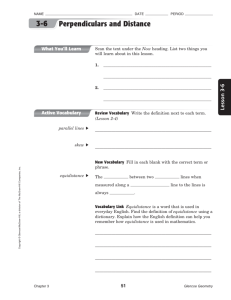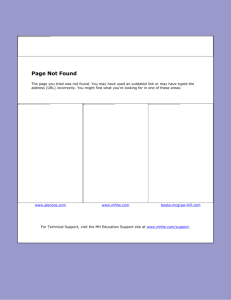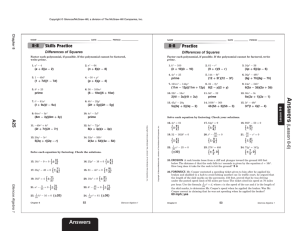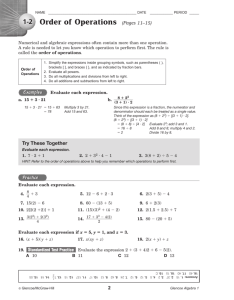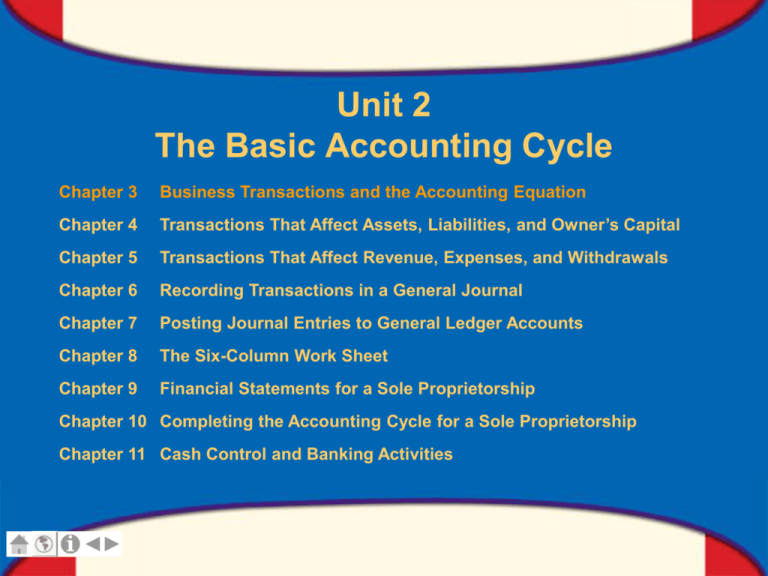
Unit 2
The Basic Accounting Cycle
Chapter 3
Business Transactions and the Accounting Equation
Chapter 4
Transactions That Affect Assets, Liabilities, and Owner’s Capital
Chapter 5
Transactions That Affect Revenue, Expenses, and Withdrawals
Chapter 6
Recording Transactions in a General Journal
Chapter 7
Posting Journal Entries to General Ledger Accounts
Chapter 8
The Six-Column Work Sheet
Chapter 9
Financial Statements for a Sole Proprietorship
Chapter 10 Completing the Accounting Cycle for a Sole Proprietorship
Chapter 11 Cash Control and Banking Activities
Glencoe Accounting Unit 2 Chapter 3 Copyright © by The McGraw-Hill Companies, Inc. All rights reserved.
0
Chapter 3
Business Transactions and
the Accounting Equation
What You’ll Learn
Describe the relationship between property and
financial claims.
Explain the meaning of the term equities as it is
used in accounting.
List and define each part of the accounting
equation.
Demonstrate the effects of transactions on the
accounting equation.
Check the balance of the accounting equation after
a business transaction has been analyzed and
recorded.
Define the accounting terms introduced in this
chapter.
Glencoe Accounting Unit 2 Chapter 3 Copyright © by The McGraw-Hill Companies, Inc. All rights reserved.
1
Chapter 3, Section 1
Property and Financial Claims
What Do You Think?
Why is it important to keep track of financial claims?
Glencoe Accounting Unit 2 Chapter 3 Copyright © by The McGraw-Hill Companies, Inc. All rights reserved.
2
SECTION 3.1
Property and Financial Claims
Main Idea
Any item of property has at least one financial claim
against it.
You Will Learn
what it means to own property.
the two types of financial claims to property.
Glencoe Accounting Unit 2 Chapter 3 Copyright © by The McGraw-Hill Companies, Inc. All rights reserved.
3
SECTION 3.1
Property and Financial Claims
Property
Property is anything of value that a person or business
owns. A purpose of accounting is to provide:
financial information about property.
financial claims (legal rights) to property.
Glencoe Accounting Unit 2 Chapter 3 Copyright © by The McGraw-Hill Companies, Inc. All rights reserved.
4
SECTION 3.1
Property and Financial Claims
Property
There is a relationship between property and financial
claims that can be expressed as an equation:
PROPERTY = FINANCIAL CLAIMS
When you buy something and agree to pay for it later,
you are buying it on credit, and you share the financial
claim with the creditor (the business or person selling
you the item on credit).
Glencoe Accounting Unit 2 Chapter 3 Copyright © by The McGraw-Hill Companies, Inc. All rights reserved.
5
SECTION 3.1
Property and Financial Claims
Financial Claims in Accounting
A company can possess various property or items of
value, known as assets:
cash
office equipment
manufacturing equipment
buildings
land
Equities are financial claims to these assets. When a
business obtains a loan to help purchase an item, the
owner’s financial claims to the assets are called the
owner’s equity.
Glencoe Accounting Unit 2 Chapter 3 Copyright © by The McGraw-Hill Companies, Inc. All rights reserved.
6
SECTION 3.1
Property and Financial Claims
Financial Claims in Accounting
The creditor’s financial claims to the assets are called
liabilities. The relationship between assets, liabilities,
and owner’s equity are shown in the accounting
equation:
Glencoe Accounting Unit 2 Chapter 3 Copyright © by The McGraw-Hill Companies, Inc. All rights reserved.
7
Property and Financial Claims
SECTION 3.1
Key Terms
property
financial claim
credit
creditor
assets
equities
owner’s equity
liabilities
accounting equation
Glencoe Accounting Unit 2 Chapter 3 Copyright © by The McGraw-Hill Companies, Inc. All rights reserved.
8
Chapter 3, Section 2
Transactions That Affect Owner’s
Investment, Cash, and Credit
What Do You Think?
What do you think is meant by the term transaction?
Glencoe Accounting Unit 2 Chapter 3 Copyright © by The McGraw-Hill Companies, Inc. All rights reserved.
9
SECTION 3.2
Transactions That Affect Owner’s
Investment, Cash, and Credit
Main Idea
Accounts are used to analyze business transactions.
You Will Learn
how businesses use accounts.
the steps used to analyze a business transaction.
Glencoe Accounting Unit 2 Chapter 3 Copyright © by The McGraw-Hill Companies, Inc. All rights reserved.
10
SECTION 3.2
Transactions That Affect Owner’s
Investment, Cash, and Credit
Business Transactions
A business transaction is an event that causes a
change in assets, liabilities, or owner’s equity. A
business records these changes in subdivisions called
accounts.
The number of accounts will vary from business to
business. Two possible business accounts are
accounts receivable, an asset account, and
accounts payable, a liability account.
Glencoe Accounting Unit 2 Chapter 3 Copyright © by The McGraw-Hill Companies, Inc. All rights reserved.
11
SECTION 3.2
Transactions That Affect Owner’s
Investment, Cash, and Credit
Effects of Transactions on the
Accounting Equation
To analyze a business transaction, follow these steps:
Identify the accounts affected.
Classify the accounts affected.
Determine the amount of increase or decrease for
each account affected.
Make sure the accounting equation remains in
balance.
Glencoe Accounting Unit 2 Chapter 3 Copyright © by The McGraw-Hill Companies, Inc. All rights reserved.
12
SECTION 3.2
Transactions That Affect Owner’s
Investment, Cash, and Credit
Investments by the Owner
Money or other property paid out in order to produce
profit is an investment. Analyze a cash investment
transaction:
Glencoe Accounting Unit 2 Chapter 3 Copyright © by The McGraw-Hill Companies, Inc. All rights reserved.
13
SECTION 3.2
Transactions That Affect Owner’s
Investment, Cash, and Credit
Investments by the Owner
Money or other property paid out in order to produce
profit is an investment. Analyze a cash investment
transaction:
Glencoe Accounting Unit 2 Chapter 3 Copyright © by The McGraw-Hill Companies, Inc. All rights reserved.
14
SECTION 3.2
Transactions That Affect Owner’s
Investment, Cash, and Credit
Glencoe Accounting Unit 2 Chapter 3 Copyright © by The McGraw-Hill Companies, Inc. All rights reserved.
15
SECTION 3.2
Transactions That Affect Owner’s
Investment, Cash, and Credit
Glencoe Accounting Unit 2 Chapter 3 Copyright © by The McGraw-Hill Companies, Inc. All rights reserved.
16
SECTION 3.2
Transactions That Affect Owner’s
Investment, Cash, and Credit
Cash Payment Transaction
Analyze a cash purchase business transaction:
Glencoe Accounting Unit 2 Chapter 3 Copyright © by The McGraw-Hill Companies, Inc. All rights reserved.
17
SECTION 3.2
Transactions That Affect Owner’s
Investment, Cash, and Credit
Cash Payment Transaction
Analyze a cash purchase business transaction:
Glencoe Accounting Unit 2 Chapter 3 Copyright © by The McGraw-Hill Companies, Inc. All rights reserved.
18
SECTION 3.2
Transactions That Affect Owner’s
Investment, Cash, and Credit
Credit Transaction
Purchasing an item on credit is also called buying on account.
Analyze a purchase on account business transaction:
Glencoe Accounting Unit 2 Chapter 3 Copyright © by The McGraw-Hill Companies, Inc. All rights reserved.
19
SECTION 3.2
Transactions That Affect Owner’s
Investment, Cash, and Credit
Credit Transaction
Purchasing an item on credit is also called buying on account.
Analyze a purchase on account business transaction:
Glencoe Accounting Unit 2 Chapter 3 Copyright © by The McGraw-Hill Companies, Inc. All rights reserved.
20
Transactions That Affect Owner’s
Investment, Cash, and Credit
SECTION 3.2
Key Terms
business transaction
account
accounts receivable
accounts payable
investment
on account
Glencoe Accounting Unit 2 Chapter 3 Copyright © by The McGraw-Hill Companies, Inc. All rights reserved.
21
Chapter 3, Section 3
Transactions That Affect Revenue,
Expense, and Withdrawals by the Owner
What Do You Think?
How do you think revenue, expenses, investments and
withdrawals affect owner’s equity?
Glencoe Accounting Unit 2 Chapter 3 Copyright © by The McGraw-Hill Companies, Inc. All rights reserved.
22
SECTION 3.3
Transactions That Affect
Revenue, Expense, and
Withdrawals by the Owner
Main Idea
Owner’s equity is changed by revenue, expenses,
investments, and withdrawals.
You Will Learn
how revenue and expenses affect owner’s equity.
how withdrawals affect owner’s equity.
Glencoe Accounting Unit 2 Chapter 3 Copyright © by The McGraw-Hill Companies, Inc. All rights reserved.
23
SECTION 3.3
Transactions That Affect
Revenue, Expense, and
Withdrawals by the Owner
Revenue and Expense Transactions
Examples of revenue, income earned from the sales of
goods and services, are
fees earned for services performed, and
cash received from the sale of merchandise.
To generate revenue, a business may also incur
expenses, or costs. Examples of expenses are
rent,
utilities, and
advertising.
Glencoe Accounting Unit 2 Chapter 3 Copyright © by The McGraw-Hill Companies, Inc. All rights reserved.
24
SECTION 3.3
Transactions That Affect
Revenue, Expense, and
Withdrawals by the Owner
Revenue and Expense Transactions
Revenues increase owner’s equity and expenses
decrease owner’s equity.
Glencoe Accounting Unit 2 Chapter 3 Copyright © by The McGraw-Hill Companies, Inc. All rights reserved.
25
SECTION 3.3
Transactions That Affect
Revenue, Expense, and
Withdrawals by the Owner
Withdrawals by the Owner
An owner can make a withdrawal of cash or other
assets from the business assets if revenue is earned.
A withdrawal has the opposite effect on owner’s equity
than investments:
Withdrawals decrease assets and owner’s equity.
Investments increase assets and owner’s equity.
Glencoe Accounting Unit 2 Chapter 3 Copyright © by The McGraw-Hill Companies, Inc. All rights reserved.
26
SECTION 3.3
Transactions That Affect
Revenue, Expense, and
Withdrawals by the Owner
Key Terms
revenue
expense
withdrawal
Glencoe Accounting Unit 2 Chapter 3 Copyright © by The McGraw-Hill Companies, Inc. All rights reserved.
27
CHAPTER 3
Chapter 3 Review
Question 1
O’Donnell’s Car Wash has the following assets and
liabilities.
Assets: Cash in Bank $9,500; Accounts Receivable
$500; Computer Equipment $3,500; Car Wash
Equipment $75,000; Building $450,000
Liabilities: Alto’s Equipment Service $2,500;
First National Bank (mortgage on building) $200,000
What is the owner’s equity for O’Donnell’s?
Glencoe Accounting Unit 2 Chapter 3 Copyright © by The McGraw-Hill Companies, Inc. All rights reserved.
28
Chapter 3 Review
CHAPTER 3
Answer 1
Step 1: Calculate total assets.
$9,500 + $500 + $3,500 + $75,000 + $450,000 = $538,500
Step 2: Calculate total liabilities.
$2,500 + $200,000 = $205,500
Step 3: Calculate owner’s equity.
$538,500 - $202,500 = $336,000
Glencoe Accounting Unit 2 Chapter 3 Copyright © by The McGraw-Hill Companies, Inc. All rights reserved.
29
CHAPTER 3
Chapter 3 Review
Question 2
A business owner invests $12,000 cash in the business.
How would you analyze this transaction?
Glencoe Accounting Unit 2 Chapter 3 Copyright © by The McGraw-Hill Companies, Inc. All rights reserved.
30
CHAPTER 3
Chapter 3 Review
Answer 2
1. Identify the accounts affected.
a. Cash in Bank is affected.
b. Owner’s Capital is affected.
2. Classify the accounts affected
a. Cash in Bank is an asset account.
b. Owner’s Capital is an owner’s equity account.
3. Determine the amount of increase or decrease for
each account affected.
a. Cash in Bank is increased by $12,000.
b. Owner’s Capital is increased by $12,000.
4. Make sure the accounting equation remains in
balance.
Assets = Liabilities + Owner’s Equity
$12,000 =
0
+ $12,000
Glencoe Accounting Unit 2 Chapter 3 Copyright © by The McGraw-Hill Companies, Inc. All rights reserved.
31
Resources
Glencoe Accounting Online Learning Center
English Glossary
Spanish Glossary
Glencoe Accounting Unit 2 Chapter 3 Copyright © by The McGraw-Hill Companies, Inc. All rights reserved.
32


